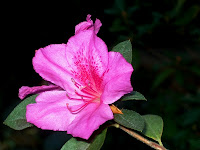
Again & again I returned to a pond filled with Bulrush (reeds) during our recent vacation at Hole-In-The-Wall [SEE: blog-entry below = 15 Dec 2011] because I had discovered that it was inhabited by a relatively large flock of
Thickbilled weavers. Built solely by the male,
the nest of a Thickbilled weaver is usually suspended between at least 2 upright stems of Bulrush (or other reeds).

In contrast to the nests of most "true" weavers (of mainly yellow plumage) with their "bottom" entrances, the nest of a Thickbilled weaver has a larger, "side-top" entrance & looks like a
domed cup.

With amusement I watched this
weaver chick appearing to be as curious as I was fascinated by its existence. 2-4 eggs in a Thickbilled weaver nest are incubated only by the female between 14-16 days.
 A chick
A chick leaves the nest after 19-22 days, but at first is still fed by the female. I snapped a series of photos of this tiny Thickbilled weaver appearing barely able to "hang on" after obviously having just left its nest for the very first time . . .

. . . whilst 2 somewhat
older chicks looked on/appeared amazed by the tiny one's "antics". Whilst this happened in a relatively silent manner . . .

. . . other chicks - precariously balancing on the bulrush -
chirped loudly from hunger & to catch their mother's attention.

Occassionally a
female Thickbilled weaver - similar in appearance to the youngsters - "made an appearance" . . .

. . . which seemed to appease the
chicks, even if they weren't fed. After all the "excitement" the youngsters appeared to tire easily, so the chirping stopped for a while - only to resume the moment they sensed a female's pressence.

With a magnificent
specimen (= male) on display, the following came to mind ("pronounced" by 1 of the chicks): When I grow up . . .
 Before I leave on my first tour (as a South African tourist guide) this (new) year & hopefully return with some "magic" photos, I want to share some exotic (NOT indigenous) flower-power. First up: an Azalea . . .
Before I leave on my first tour (as a South African tourist guide) this (new) year & hopefully return with some "magic" photos, I want to share some exotic (NOT indigenous) flower-power. First up: an Azalea . . .



















